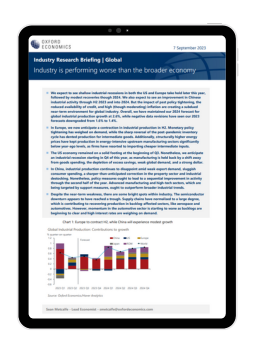Industry is performing worse than the broader economy globally

We expect to see shallow industrial recessions in both the US and Europe take hold later this year, followed by modest recoveries though 2024. We also expect to see an improvement in Chinese industrial activity through H2 2023 and into 2024. But the impact of past policy tightening, the reduced availability of credit, and high (though moderating) inflation are creating a subdued near-term environment for global industry.
What you will learn:
- The US economy remained on a solid footing at the beginning of Q3. Nonetheless, we anticipate an industrial recession starting in Q4 of this year.
- In China, industrial production continues to disappoint amid weak export demand, sluggish consumer spending, a sharper-than-anticipated correction in the property sector and industrial destocking. Nonetheless, advanced manufacturing and high-tech sectors, which are being targeted by support measures, ought to outperform broader industrial trends.
- Despite the near-term weakness, there are some bright spots within industry. The semiconductor downturn appears to have reached a trough. Supply chains have normalised to a large degree, which is contributing to recovering production in backlog-affected sectors.
Tags:
Related Posts

Post
Oxford Economics enhances its Commodity Price Forecasts coverage
Oxford Economics expands Commodity Price Forecasts service to include battery metals, agricultural commodities and plastics.
Find Out More
Post
The socio-economic impact of TikTok in Australia
This report provides the results of our economic modelling of TikTok’s economic contribution to the Australian economy, as well as the findings of survey research into TikTok’s users and Australian businesses. It looks at the real world impacts users report as well as the diversity of TikTok’s online communities.
Find Out More
Post
Why we believe the industry cycle in the Eurozone is finally turning
Even though incoming hard data on eurozone industry is still downbeat, leading indicators suggest that we're at a turning point. We expect favourable cyclical and structural tailwinds will now take over, and industry output to accelerate through this year to 2% y/y growth by Q4.
Find Out More